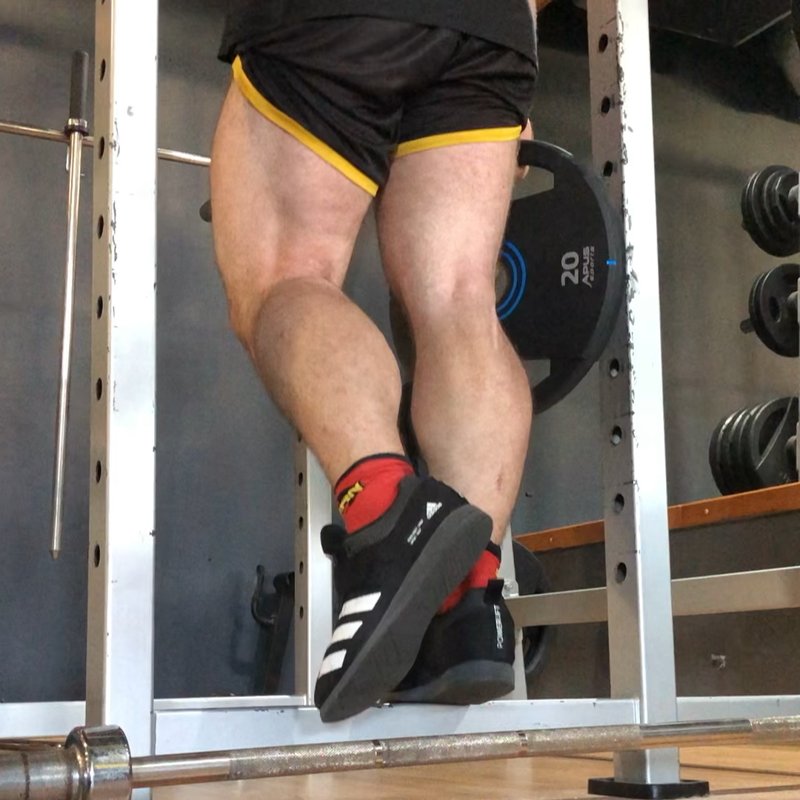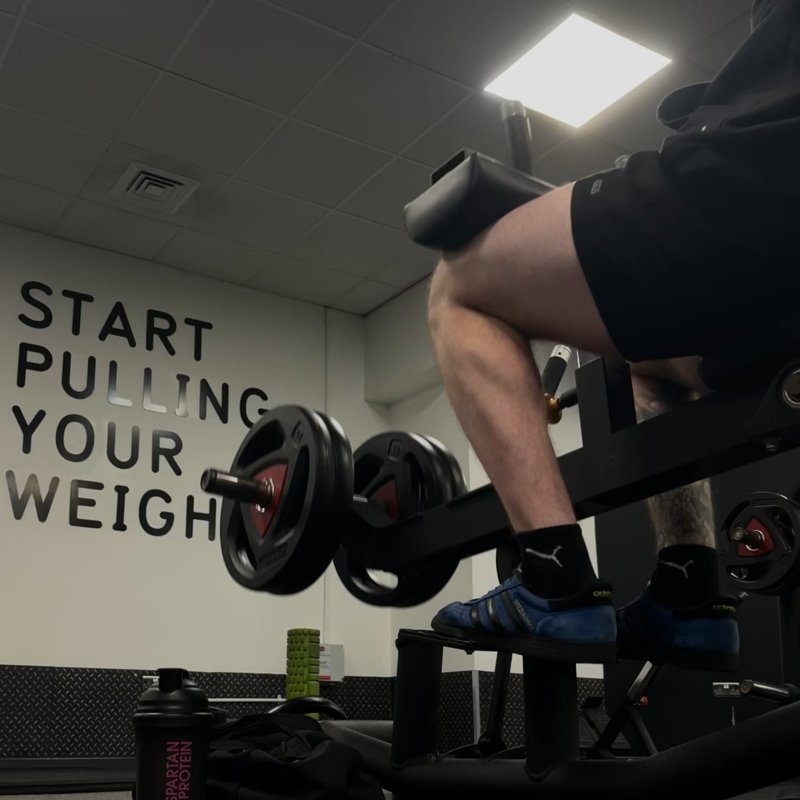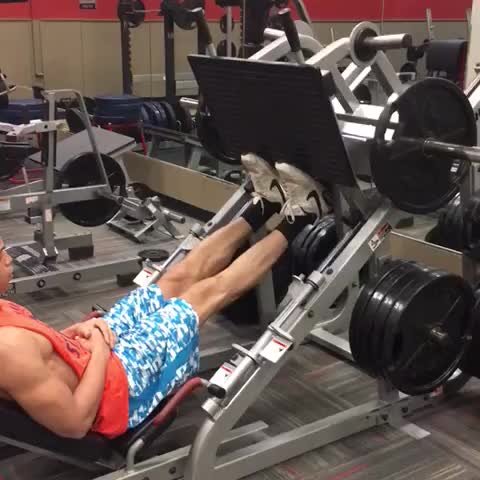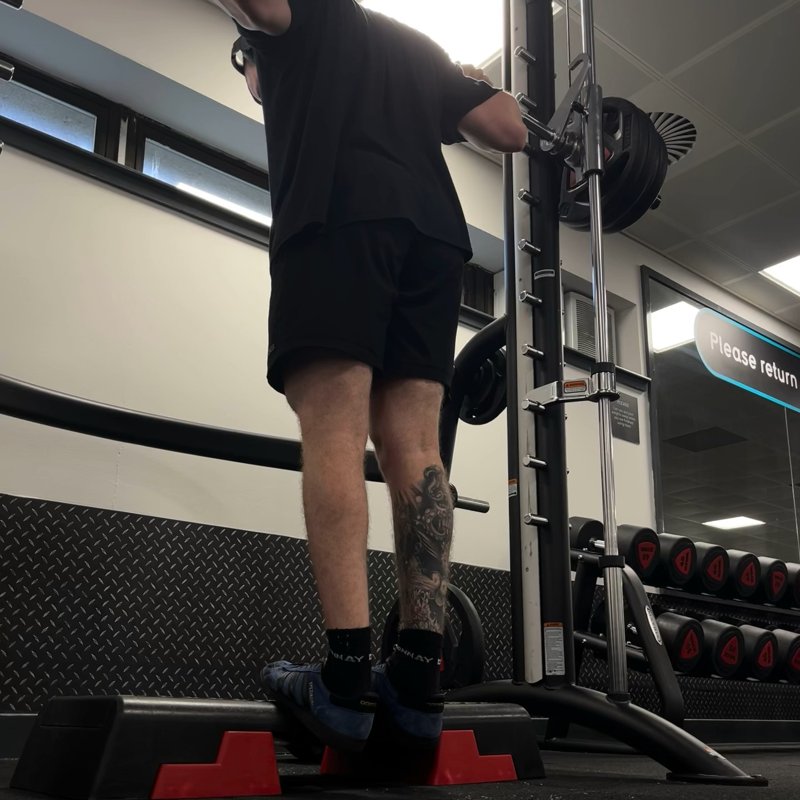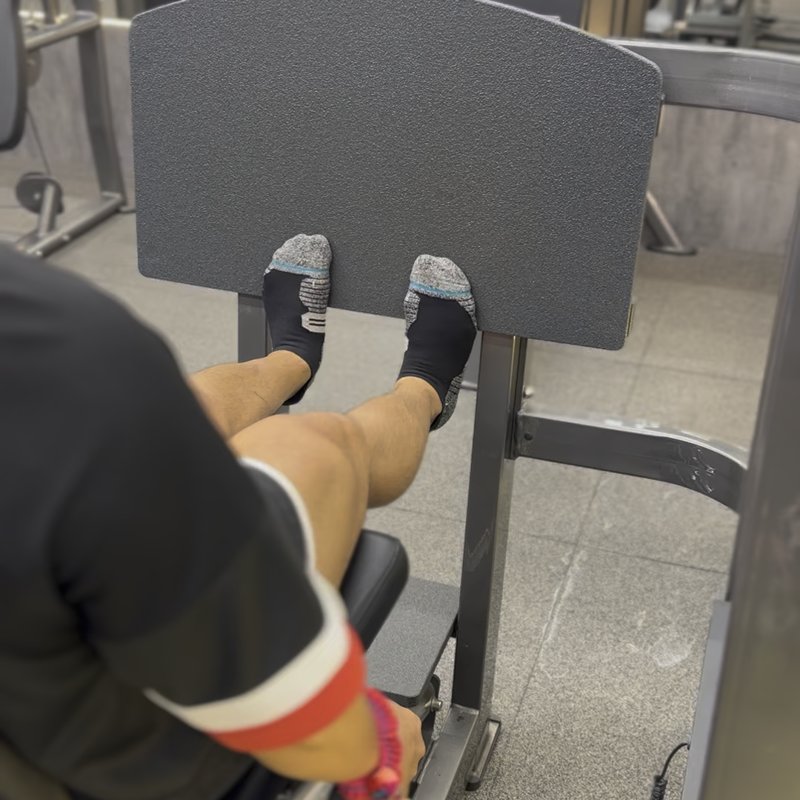Calf Press: The Ultimate Guide
The Calf Press is a lower leg exercise that primarily targets the gastrocnemius and soleus muscles by performing ankle plantar flexion against resistance, typically on a leg press machine.
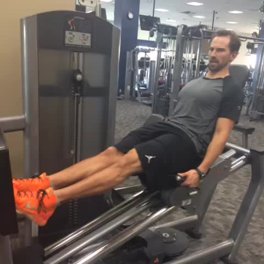
Quick Facts
Key Benefit
Calf size and strength with significant loading potential
Primary Muscles
Secondary Muscles
Posterior Deltoids
Equipment
machine
Difficulty
Beginner
Type
Isolation
In This Guide
Ready to master the Calf Press?
Track your progress, see improvements over time, and build strength consistently.
Download GravitusThe Calf Press is an effective isolation exercise that directly targets the calf muscles—the gastrocnemius and soleus—which are responsible for ankle plantar flexion and play crucial roles in lower body power, balance, and aesthetics. While similar in basic mechanics to standing calf raises, the calf press performed on a leg press machine offers some unique advantages. What makes this variation particularly valuable is its ability to handle very heavy loads safely due to the stable, supported position. By performing the exercise on a leg press machine, the upper body and core are removed from the stability equation, allowing you to focus entirely on calf development without the balance or grip strength limitations that can occur with other calf exercises. The seated or reclined position also places the knees in a bent position, which can shift emphasis toward the soleus muscle compared to straight-knee variations. Additionally, the typical 45-degree angle of most leg press machines creates a slightly different force angle than vertical calf training, potentially stimulating the muscles from a novel perspective. Whether your goal is to build more muscular calves, increase ankle strength for athletic performance, or simply add variety to your lower body training, the calf press delivers targeted stimulation in a joint-friendly format suitable for lifters of virtually all experience levels.
Benefits of Calf Press
The calf press offers several unique advantages compared to other calf exercises.
Heavy Loading Capacity
The leg press setup allows for handling substantially more weight than many other calf exercises, potentially offering greater stimulus for growth.
Stable Positioning
The supported position eliminates balance requirements, enabling complete focus on calf muscle activation rather than stabilization.
Soleus Emphasis
The bent-knee position during execution shifts more emphasis to the soleus muscle compared to straight-knee calf exercises.
Reduced Upper Body Fatigue
Unlike standing machine calf raises where shoulders bear the weight, the leg press variation removes upper body stress entirely.
Range of Motion Control
The machine setup makes it easier to control depth and peak contraction, potentially enhancing exercise effectiveness.
Specialized Angle
The typical 45-degree angle of most leg press machines creates a unique force vector that differs from both seated and standing calf exercises.
Proper Form & Technique
Setup
- Position yourself in the leg press machine as you would for a regular leg press exercise.
- Adjust the seat position so that your knees are bent at approximately 90 degrees in the starting position.
- Place the balls of your feet on the lower portion of the footplate with your heels extending off the edge.
- Position your feet about hip-width apart with toes pointing straight ahead or slightly outward.
- Ensure your knees are aligned with your toes to maintain proper joint mechanics.
- Release the safety mechanisms and lower the platform slightly to a point where your calves can work through a full range of motion.
- Grasp the handles or sides of the machine for stability.
- Prepare for the movement by engaging your core and establishing a stable position.
Movement
- Begin with your ankles in a stretched position, allowing your heels to drop below the level of your toes.
- Feel a good stretch in your calf muscles at the bottom position before initiating the movement.
- Press through the balls of your feet, extending your ankles to raise your heels (plantar flexion).
- Continue pressing until your ankles reach full extension, where you're up on the balls of your feet as high as possible.
- Squeeze your calves at the top position, holding the contraction briefly for 1-2 seconds to maximize activation.
- Slowly lower your heels back to the starting position, controlling the descent rather than letting the weight drop.
- Allow your heels to descend below the level of your toes again to ensure a full stretch.
- Repeat for the desired number of repetitions, maintaining control throughout the entire set.
Key Form Tips
Range of Motion
Focus on achieving both full stretch at the bottom position and complete contraction at the top of each repetition.
Foot Position
Keep the balls of your feet planted firmly on the footplate throughout the entire movement.
Controlled Tempo
Use a deliberate pace—perhaps 2 seconds up, 1-second squeeze, 2 seconds down—to maximize muscle stimulation.
Isolated Movement
Ensure the motion comes only from your ankles, not from pushing with your knees or hips.
Mind-Muscle Connection
Concentrate on feeling your calf muscles working rather than just moving the weight up and down.
Muscles Worked
Primary Muscles
- Gastrocnemius: The larger, two-headed muscle that forms the visible bulge on the back of the lower leg, which is the primary mover during ankle plantar flexion.
- Soleus: The deeper, flat muscle that lies underneath the gastrocnemius, which receives significant activation due to the bent-knee position during the calf press.
Secondary Muscles
- posterior deltoids: A deep muscle that helps stabilize the ankle during the movement and assists with plantar flexion.
- Flexor Hallucis Longus: The muscle responsible for big toe flexion, which assists with ankle plantar flexion, especially during the top phase of the movement.
- Flexor Digitorum Longus: The muscle that flexes the smaller toes, which contributes to overall stability and assistance during the calf press.
- Plantaris: A small muscle that works alongside the gastrocnemius, providing minor assistance during the movement.
Common Mistakes and How to Fix Them
Insufficient Range of Motion
Not lowering the heels far enough or not rising fully onto the balls of the feet limits muscle development. Focus on achieving a full stretch at the bottom position, allowing your heels to drop below the level of your toes. At the top, rise as high as possible onto the balls of your feet, squeezing your calves at the peak contraction. If flexibility limitations prevent a full stretch, incorporate specific calf and ankle mobility work into your warm-up routine. Quality of movement through the complete range is more important than the amount of weight used—consider reducing the load if necessary to achieve optimal range of motion.
Using Excessive Weight
Prioritizing heavy weights over proper execution reduces effectiveness and increases injury risk. Select a weight that allows for controlled movement through the full range of motion while still providing sufficient challenge. Signs that the weight is too heavy include bouncing at the bottom, incomplete range of motion, or using momentum rather than muscular control. Remember that the calves respond well to both heavy, lower-rep training and lighter, higher-rep work with perfect form—incorporating both approaches across different training sessions often yields the best results for stubborn calf development.
Pushing with the Legs
Using knee or hip extension to assist the movement rather than isolating the ankle joint. Keep your knee angle constant throughout the entire exercise, with movement occurring only at the ankle joint. If you notice your legs straightening during the movement, you're likely using too much weight or not focusing properly on the target muscles. Think of your legs as fixed levers, with all the work happening from the balls of your feet. Some lifters find it helpful to perform a few practice repetitions with very light weight while placing a hand on their calves to ensure they're feeling the contraction in the right place.
Bouncing at the Bottom
Using momentum by bouncing at the bottom of the movement rather than controlling the stretch and contraction. Avoid the temptation to rebound quickly from the bottom position, which reduces muscle tension and effectiveness. Instead, implement a brief pause at the bottom position to eliminate momentum and enhance the stretch sensation. Control both the positive (lifting) and negative (lowering) portions of the exercise with deliberate tempo. If bouncing is persistent, it typically indicates the weight is too heavy—reduce the load and focus on quality execution.
Improper Foot Position
Positioning the feet too high or too low on the footplate can alter the effectiveness of the exercise. The balls of your feet should be firmly planted on the footplate with your heels extending off the edge, allowing for full range of ankle movement. If your feet are too far forward (too much of the foot on the platform), you'll limit your range of motion. If positioned too far back, you may find it difficult to maintain stable contact throughout the movement. Find the position that allows your heels to drop below the level of your toes at the bottom while maintaining solid contact between the balls of your feet and the platform throughout the entire exercise.
Lifting Heels from the Platform
Allowing the balls of your feet to rise off the footplate during the contraction phase. Keep the balls of your feet firmly planted on the platform throughout the entire movement, even as you rise to the fully contracted position. The movement should involve your heels rising while the balls of your feet remain in constant contact with the footplate. If you find your feet shifting or losing contact, it may indicate improper foot positioning or excessive weight. Focus on pressing through the balls of your feet rather than rolling onto your toes, which maintains optimal leverage and muscle activation patterns.
Exercise Variations
Foot Position Variations
-

Toes-Forward Calf Press
Keeping toes pointed directly forward to distribute work evenly across the calf muscles.
-

Toes-Out Calf Press
Positioning feet with toes pointed outward to place greater emphasis on the inner head of the gastrocnemius.
-

Toes-In Calf Press
Positioning feet with toes pointed inward to shift more focus to the outer head of the gastrocnemius.
-

Wide-Stance Calf Press
Placing feet wider than hip-width to create a slightly different loading pattern across the calf musculature.
Rep Scheme Variations
-

Heavy Calf Press
Using substantial weight for lower repetitions (6-10) to focus on strength development and target fast-twitch muscle fibers.
-

High-Rep Calf Press
Employing moderate weight for higher repetitions (15-30) to increase endurance and target slow-twitch fibers predominant in the calves.
-

Drop Set Calf Press
Starting with a heavy weight for 8-10 repetitions, then immediately reducing the load and continuing for additional repetitions without rest.
-

Rest-Pause Calf Press
Performing a set to near failure, resting 10-15 seconds, then continuing for more repetitions with the same weight, repeated several times.
Technical Variations
-

Single-Leg Calf Press
Performing the movement with one leg at a time to address muscle imbalances and potentially increase the range of motion and mind-muscle connection.
-

Pulse Calf Press
Using small, partial-range movements at the top contracted position to increase time under tension and target different muscle fibers.
-

Isometric Calf Press
Adding a 5-10 second hold at the fully contracted position to increase time under tension and enhance the mind-muscle connection.
-

Eccentric-Focused Calf Press
Emphasizing the lowering phase with a 4-5 second negative to increase muscle damage and growth stimulus, particularly effective for stubborn calves.
Frequently Asked Questions
The calves, unlike many other muscle groups, can generally tolerate and benefit from higher training frequency due to their daily use in walking, standing, and other activities. For most people, training calves 2-3 times per week provides a good starting point, with sessions spaced relatively evenly throughout the week (e.g., Monday/Thursday or Monday/Wednesday/Friday). However, if calf development is a specific priority or lagging body part, increasing frequency to 4-6 times weekly can be effective, provided the volume per session is managed appropriately to prevent overtraining. More advanced lifters with stubborn calves have reported success with twice-daily training protocols—brief, intense sessions in both morning and evening—though this approach should be time-limited (4-6 weeks) and monitored closely for recovery. When determining optimal frequency, consider your overall training volume, recovery capacity, and program balance. If you're already performing exercises that indirectly work the calves (like walking, running, jumping, or heavy leg presses), you may need less direct calf work. The key indicator is progress—if your calves are developing well with your current frequency, there's no need to increase it. If development has stalled despite good execution and progressive overload, experimenting with higher frequency may provide the novel stimulus needed for continued growth.
Neither exercise is inherently "better"—they each offer distinct advantages that make them complementary rather than competitive. The calf press on a leg press machine typically allows for handling heavier loads safely due to the supported position, removing balance requirements and upper body stress from the equation. The bent-knee position during execution also places more emphasis on the soleus muscle compared to straight-knee variations. Standing calf raises, conversely, train the calves in a more functional position with the knees extended, which more heavily targets the gastrocnemius and better mimics many athletic movements. The standing position also incorporates more stabilizer muscles and typically allows for a greater stretch at the bottom position. For optimal development, most trainees would benefit from incorporating both variations in a training program—perhaps using calf presses for higher-load work and standing raises for more functional development. The "best" choice depends on your specific goals, equipment availability, comfort, and individual biomechanics. If forced to choose just one due to limitations, consider your specific needs—prioritize standing variations for athletic performance and gastrocnemius development, or calf presses for soleus emphasis and if back or upper body fatigue is a concern.
For optimal calf development, you should rise as high as possible onto the balls of your feet at the top of each repetition. This means achieving full plantar flexion where your ankle joint is completely extended. At this position, you should feel a strong contraction in your calf muscles, with your heels raised significantly above the level of your toes. However, it's crucial to maintain solid contact between the balls of your feet and the footplate throughout—you should rise high on your toes without allowing the balls of your feet to lose contact with the platform. If you find yourself rolling forward or losing contact, adjust your foot position or reduce the weight. The height you can achieve may be somewhat limited by ankle mobility and the specific design of the leg press machine, but the goal should always be maximum range within these constraints. At the peak contraction, consider implementing a brief 1-2 second squeeze or hold to enhance mind-muscle connection and maximize the effectiveness of each repetition. Remember that the quality of contraction is more important than the absolute height achieved—focus on feeling the target muscles working strongly at the top position rather than simply trying to reach a particular height measurement.
The appropriate weight for calf presses depends on your training experience, current strength level, and specific goals. Unlike some muscle groups that respond primarily to heavy loading, the calves—with their mixed fiber composition—often benefit from a variety of loading strategies. For general development, most trainees should select a weight that allows completion of the target repetition range with proper form while creating significant tension in the calf muscles. For strength-focused training, weights that allow 6-10 controlled repetitions can be effective. For hypertrophy (muscle building), moderate weights allowing 10-15 repetitions typically work well. For endurance and pump-focused work, lighter weights for 15-30+ repetitions can provide a unique stimulus. Many successful calf training programs incorporate all these approaches across different training sessions or blocks. The calves often respond well to higher repetitions than other muscle groups due to their daily use and fiber composition, so don't be afraid to occasionally use lighter weights for very high repetition sets (20-30+). Whatever weight you choose, ensure it allows for the full range of motion—complete stretch at the bottom and full contraction at the top—as this is more important than the absolute load for calf development. As with any exercise, implement progressive overload by gradually increasing the weight over time once you can consistently perform all prescribed repetitions with good form.
Calf development can be challenging for several reasons, and addressing this common frustration requires a multi-faceted approach. First, genetics plays a significant role in calf development potential—factors like muscle belly length, tendon attachment points, and natural fiber type distribution heavily influence how your calves respond to training. This doesn't mean growth is impossible, but realistic expectations are important. Second, the calves' daily use in walking and standing makes them resistant to growth from typical training approaches—they're already accustomed to high volume and frequency. To overcome this resistance, consider these strategies: (1) Increase training frequency to 4-6 sessions weekly, as calves often respond better to higher frequency than other muscle groups; (2) Implement a variety of loading patterns—very heavy for 6-8 reps, moderate for 10-15 reps, and lighter for 20-30+ reps across different sessions; (3) Emphasize the eccentric (lowering) portion of each repetition with 3-5 second negatives, as this often stimulates more growth in stubborn muscle groups; (4) Ensure complete range of motion on every repetition—full stretch at the bottom and maximum contraction at the top; (5) Add intensity techniques like drop sets, rest-pause, or mechanical drop sets to push beyond normal fatigue barriers; (6) Consider specialized approaches like twice-daily training (brief sessions morning and evening) for 4-6 week periods; (7) Evaluate recovery factors including protein intake, overall nutrition, sleep quality, and stress management, as these significantly impact growth potential; (8) Be patient and consistent—calf development typically requires more time than other muscle groups, with visible changes often taking months of dedicated work.
Video Demonstrations
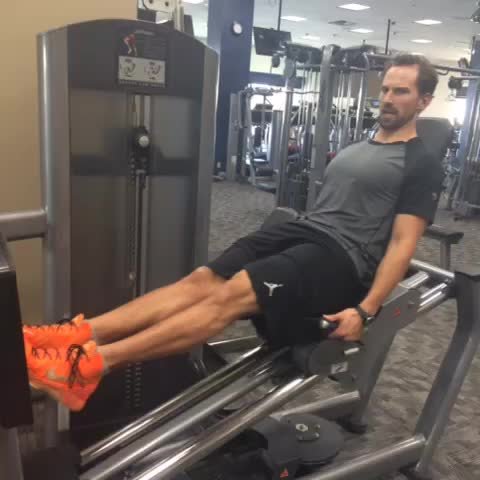
Log in to watch video demonstrations
Login to WatchTips from the Community
-

Can use straight legs but careful not to lock out as can injure your knees, can also use slightly bent knees but make sure you isolate your calves.
Track your progress with Gravitus
Download Gravitus to log your workouts, track your progress, and join a community of fitness enthusiasts.

Helpful Resources
One Rep Max Calculator
Find your one rep max for any exercise without maximal testing. Essential for developing effective strength training programs.
Calculate 1RMWorkout Programs
Follow structured workout programs created by fitness professionals to maximize your strength and muscle gains.
View Programs